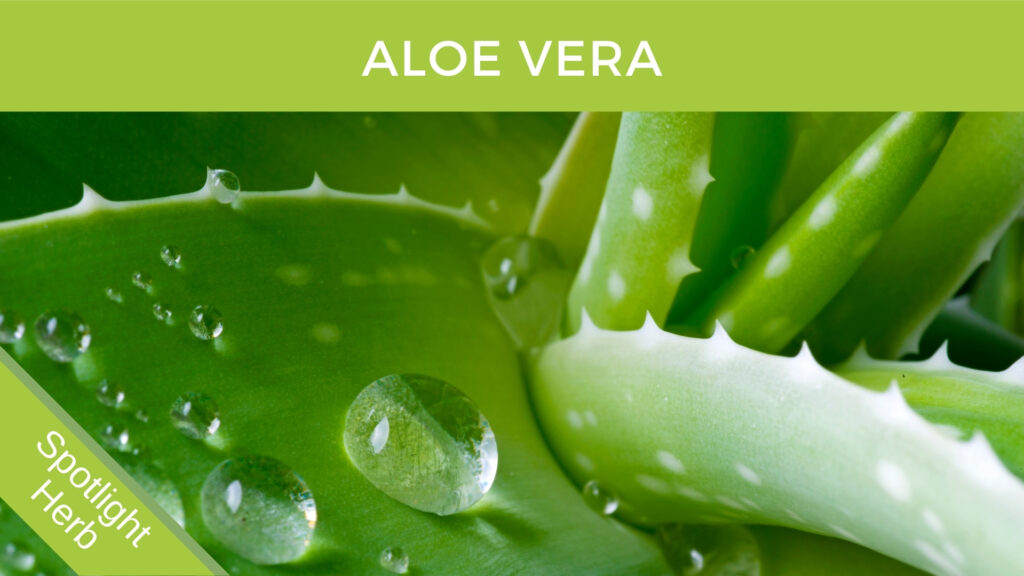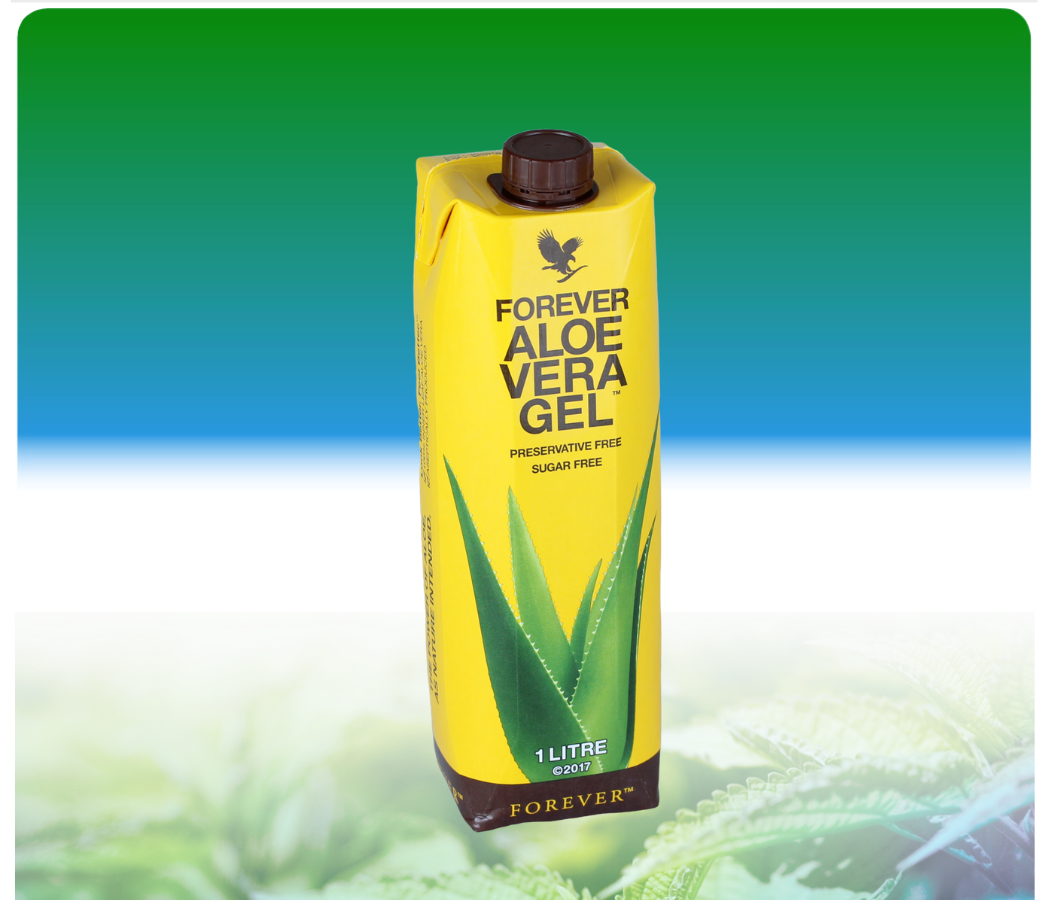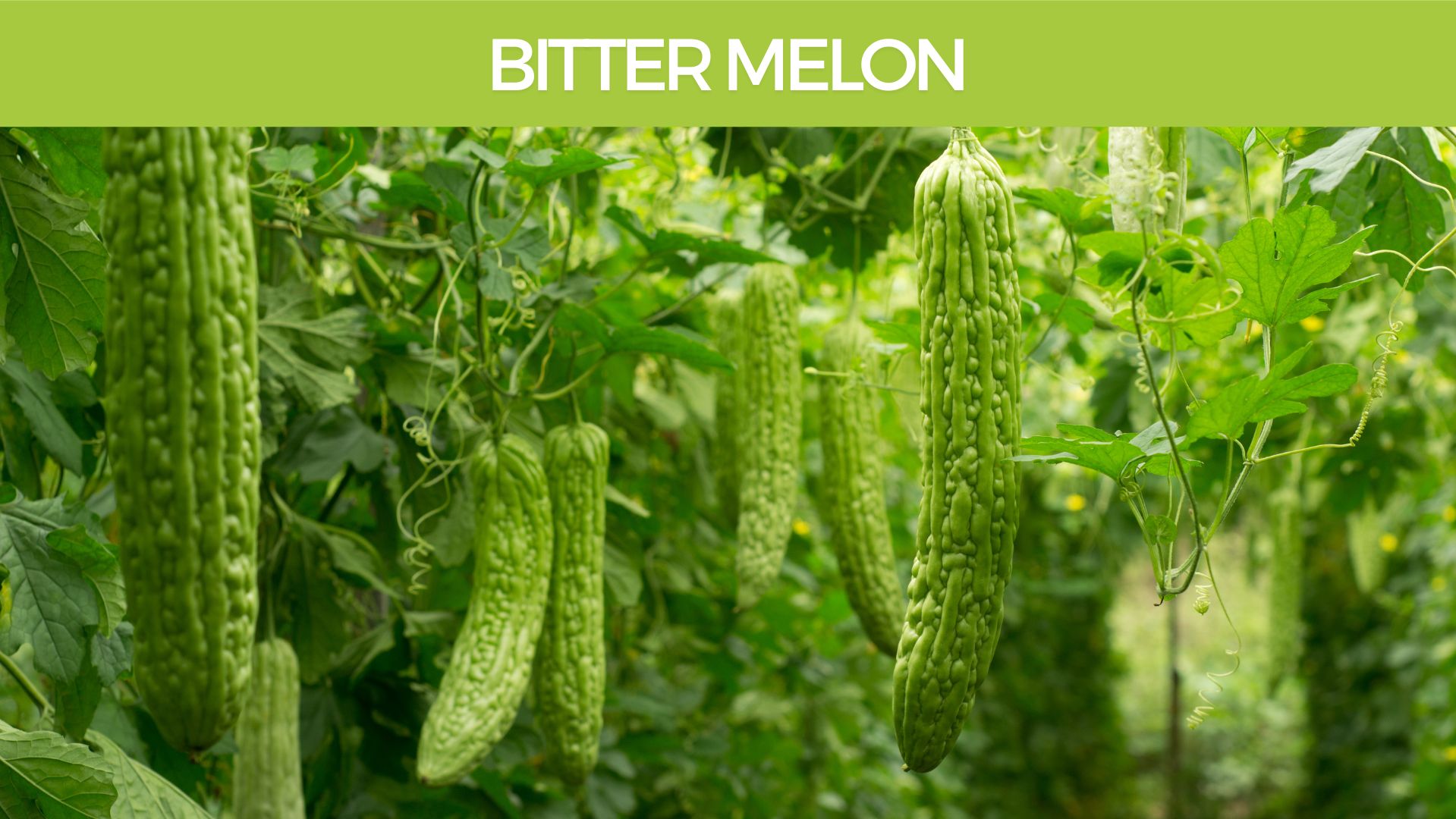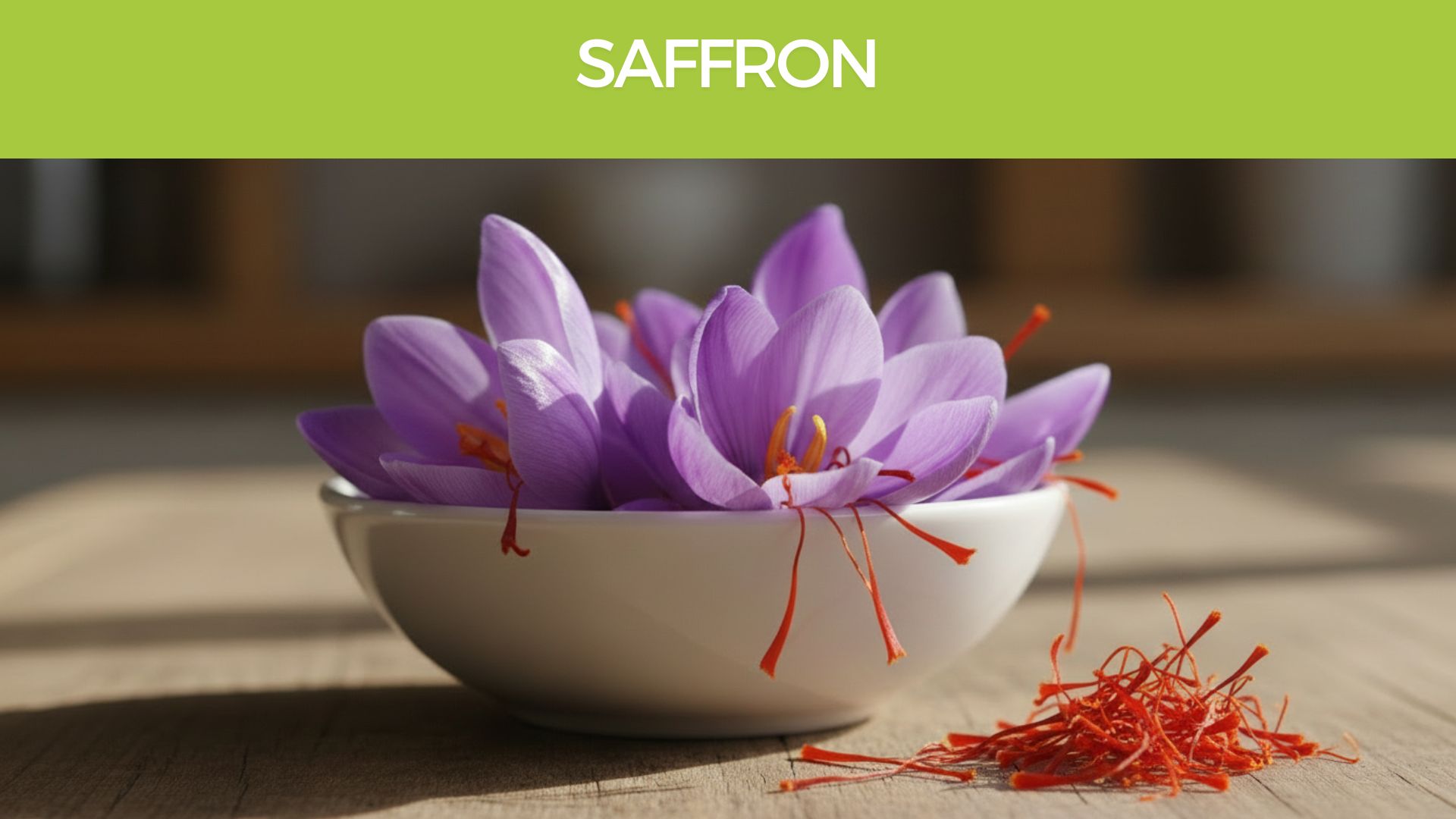- 2 years ago
- 7Minutes
- 1747Words
- 1392Views
The amazing Aloe Vera is one of the oldest and most valued herbal medicines in the world. You can buy my suggested Aloe Vera Juice Here
(1) Wikipedia https://en.wikipedia.org/wiki/Aloe_vera
(2) World Health Organization, Essential Medicines and Health Products Information Portal, WHO Monographs on Selected Medicinal Plants – Volume 1: http://apps.who.int/medicinedocs/en/d/Js2200e/5.html
(3) INTERNATIONAL AGENCY FOR RESEARCH ON CANCER: Monographs https://monographs.iarc.fr/ENG/Monographs/vol108/mono108-01.pdf
(4) Journal of Pharmaceutical Biology, Medicinal Applications and Toxicological Activities of Aloe. Products: http://www.tandfonline.com/doi/full/10.1080/13880200701215307
(5) The Commission E Monographs, Herbalgram: http://cms.herbalgram.org/commissione/Monographs/Monograph0002.html?ts=1473653480&signature=317d6f0af300b180467d00847342d762
(6) Aloe vera: a systematic review of its clinical effectiveness. PUBMED http://www.ncbi.nlm.nih.gov/pmc/articles/PMC1313538/pdf/10885091.pdf
(7) Anti-inflammatory effects of aloe vera gel in human colorectal mucosa in vitro. PUBMED: http://www.ncbi.nlm.nih.gov/pubmed/14987320
(8) Evaluation of biological properties and clinical effectiveness ofAloe vera: A systematic review. PUBMED http://www.ncbi.nlm.nih.gov/pmc/articles/PMC4488101/
(9) Acemannan sponges stimulate alveolar bone, cementum and periodontal ligament regeneration in a canine class II furcation defect model. PUBMED http://www.ncbi.nlm.nih.gov/pubmed/23710575
(10) Effectiveness of Aloe Vera gel compared with 1% silver sulphadiazine cream as burn wound dressing in second degree burns. PUBMED http://www.ncbi.nlm.nih.gov/pubmed/23894900
(11) Evaluation of the therapeutic effects of Aloe vera gel on minor recurrent aphthous stomatitis. PUBMED http://www.ncbi.nlm.nih.gov/pubmed/23162576
(12) Aloe vera: Potential candidate in health management via modulation of biological activities. PUBMED https://www.ncbi.nlm.nih.gov/pmc/articles/PMC4557234/
Description
Aloe Vera is a succulent plant species of the genus Aloe. It grows wild in tropical climates around the world and is cultivated for agricultural and medicinal uses. Aloe is also used for decorative purposes and grows successfully indoors as a potted plant.
It is found in many consumer products including juice, skin lotion, or ointments for minor burns and sunburns. (1)
Aloe arborescens (pictured) can be substituted for Aloe barbadensis and in fact, has higher concentrations of the active constituents.
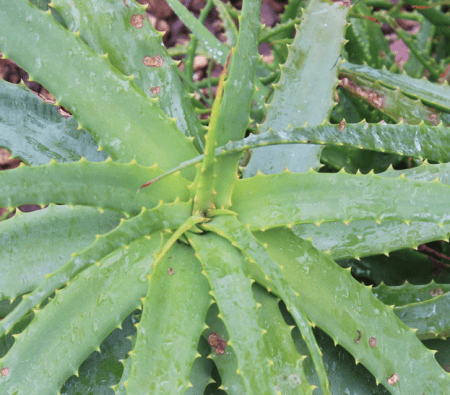
Traditional Uses
The first record of human use of Aloe Vera is in Sumerian hieroglyphics engraved on clay tablets during the Mesopotamia civilization circa 2200 BC, in which it is described as a laxative. (3)
Aloe Vera is used in traditional medicine as a multipurpose skin treatment. In Ayurvedic medicine, it is called kathalai. Early records of Aloe Vera use appear in the Ebers Papyrus from the 16th century BC and in Dioscorides’ De Materia Medica and Pliny the Elder’s Natural History – both written in the mid-first century. It is also written about in the Juliana Anicia Codex of 512 AD. (1)
Aloe (Lilliaceae) has long been used as a remedy in many cultures. Aloe products, which include latex, gel, and whole leaf, are used, among other reasons as laxatives, in creams for skin ailments, and as a treatment for a wide range of diseases, respectively. The heterogeneous nature of Aloe products may contribute to the diverse biological and therapeutic activities that have been observed. (4)
The plant is used widely in the traditional herbal medicine of many countries. (1)
Active Constituents
Aloe Vera contains 75 potentially active constituents: vitamins, enzymes, minerals, sugars, lignin, saponins, salicylic acids, and amino acids (6) and the plant has revealed the presence of more than 200 different biologically active substances. (8)
Aloe contains as its major and active principles hydroxyanthrone derivatives, mainly of the aloe-emodin-anthrone 10-C-glucoside type. The major constituent is known as barbaloin (aloin) (15–40%). It also contains hydroxyaloin (about 3%). (2)
You can see in the chart below, just what a complex range of constituents is found in Aloe Vera, making it very difficult to understand the exact mode of action.
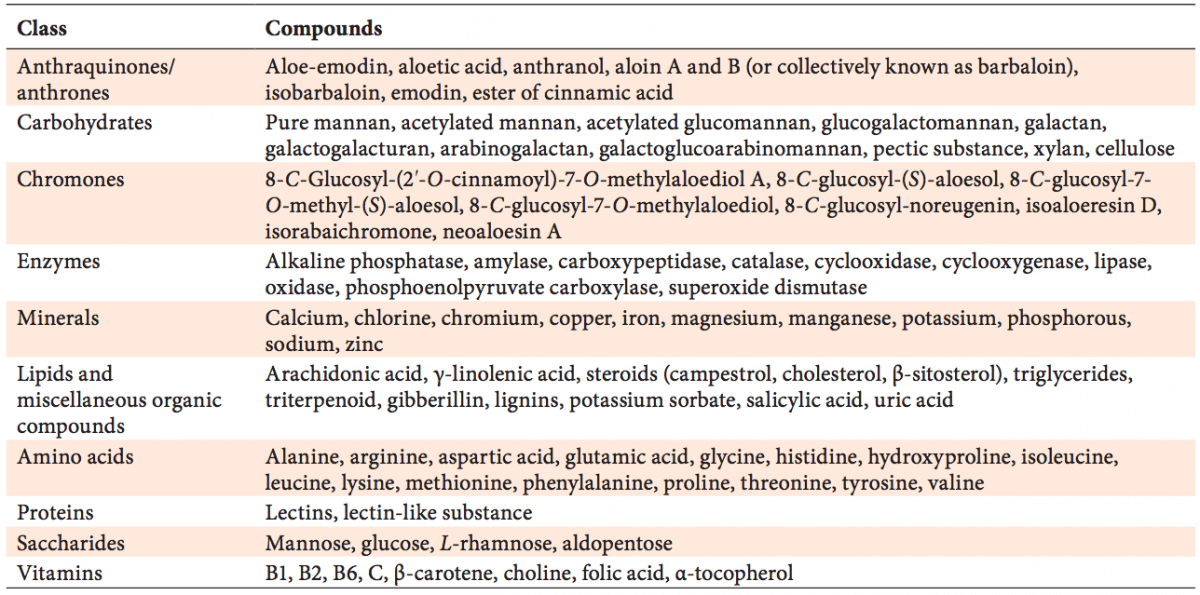
Parts Used
The Aloe vera whole leaf extract (sometimes referred to as whole leaf Aloe Vera juice, Aloe juice, or non decolorized whole leaf extract), is the aqueous extract of the whole leaf with lignified fibers removed. The whole leaf extract contains both the gel from the inner parenchyma leaf pulp and the latex. (3)
Pharmacology
1,8-dihydroxy-anthracene derivatives have a laxative effect. This effect is primarily caused by the influence on the motility of the colon, and inhibition of stationary, and stimulation of propulsive contractions. This results in an accelerated intestinal passage. (5)
Because of the shortened contraction time, a reduction in liquid absorption. In addition, stimulation of the active chloride secretion increases the water and electrolyte content. (5)
Scientific Evidence
Psoriasis
One study suggests that Aloe Vera does enhance wound healing, although its mechanism of action is still unclear. (6) For example, 60 men and women used Aloe Vera vs placebo for 4 weeks on mild to severe psoriasis. 83% were cured using Aloe Vera, compared to 6.6% using a placebo.
Wound healing
Aloe Vera may have a direct effect on the wound healing process as a whole, which is manifested by an increase in the rate of contraction of the wound area and has confirmed the effect of Aloe Vera on increasing wound contraction and collagen synthesis. This property is attributed to the mannose-6-phosphate known to be present in A. vera gel. (8)
Polysaccharides from Aloe promote both the proliferation of fibroblasts and the production of hyaluronic acid and hydroxyproline in fibroblasts, which play important roles in extracellular matrix remodeling during wound healing. (9)
Burns
In a clinical study, to check the efficacy of A. vera gel compared with 1% silver sulfadiazine cream as a burn dressing for the treatment of superficial and partial thickness burns, healing of burn wounds were remarkably early in Aloe Vera treated patients than those patients treated with 1% silver sulfadiazine. (10)
Cholesterol and Blood Sugar
Other studies suggest that oral administration of Aloe Vera might be a useful adjunct for lowering blood glucose in diabetic patients as well as for reducing blood lipid levels in patients with hyperlipidaemia. (6)
Inflammatory bowel disease
The anti-inflammatory actions of Aloe Vera gel in vitro provide support for the proposal that it may have a therapeutic effect in inflammatory bowel disease. (7)
Colon stimulation (Purgative)
Aloin, present in the gel, is metabolized by the colonic flora to reactive Aloe-emodin, which is responsible for the purgative activity.
Metabolic syndrome
In a pilot study, two Aloe products in patients with pre-diabetes over an 8-week period tended to revert the impaired fasting glucose and impaired glucose tolerance observed in conditions of pre-diabetes/metabolic syndrome. (8)
Insulin resistance
It has also been shown that Aloe Vera also reduces obesity-induced glucose tolerance not only by suppressing inflammatory responses but also by inducing anti-inflammatory cytokines in the white adipose tissue and liver, both of which are important peripheral tissues affected by insulin resistance. (8)
Gastric Ulcers
Aloe Vera is an herbal remedy widely used for a variety of illnesses; Aloe Vera leaf extracts have been promoted for digestion and are used in the treatment of peptic ulcers for cytoprotective action whereby Aloe Vera gel expresses antibacterial properties against both susceptible and resistant Helicobacter pylori strains and acts as a novel effective natural agent for combination with antibiotics for the treatment of H. pylori gastric infection. (11)
The US Food and Drug Administration has already approved the developmental study of Aloe Vera in the treatment of cancer and AIDS. (8)
Anti-Cancer
One study has shown that AE plays a role in the induction of apoptosis via activation of caspase-6 in human colon cancer cells. The findings of other studies suggest that the decrease in the expression of protein kinase C-δ and protein kinase C-ε isoforms plays a critical role in AE-induced apoptosis, while those from yet another study show that AE exhibits anticancer activity in two human colon carcinoma cell lines, DLD-1 and WiDr and that the cytotoxic mechanism involves the induction of apoptosis. (12)
Forever 100% Aloe Juice – The Best
I’ve seen lots of different Aloe juices over the years, and the Forever juice is the best I have found. It is 100% pure with no additives, and it’s thick and pulpy, not watered down like most other brands. This is the juice I recommend to clients in my clinic, and it gets great results with digestive health.
Conclusion
This is just the tip of the iceberg when it comes to the research available on Aloe Vera, so it’s no wonder after many thousands of years of knowledge and tradition this plant is finally getting the recognition it deserves.
It is one of those natural herbal remedies that you can grow in your garden, harvest yourself and use in emergencies, such as burns or injury, but it’s also a great tonic for long-term health.
I use it in my Herbal DETOX program for all of the above reasons, but mostly for its ability to bring a sense of healing and wellbeing during the program.
Aloe Vera is another example of Herbal medicine at its finest and convinces me of creation vs evolution.
Never underestimate the power of plants when it comes to medicine.
Many blessings
Brett Elliott ©
Aloe Vera is also found in Symlax bulking fiber laxative

